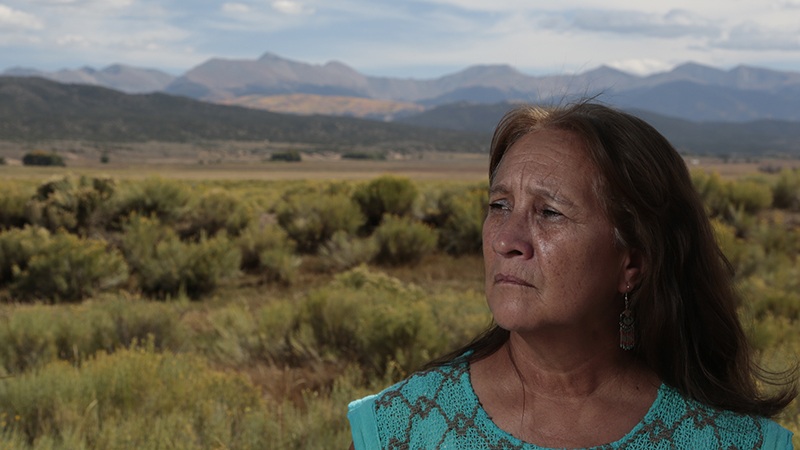In the San Luis Valley, Community Change Leaders Step Forward
Leer en español
Shirley Romero Otero is one of several San Luis Valley residents taking the lead on Community Partnerships efforts. Photo by Joe Mahoney
By Victoria Martinez
In recent years, the power structure in parts of the San Luis Valley seems to be changing. Typically, rural power is in the hands of nonprofits, governmental agencies and local government structures. However, several leaders have emerged among community residents in the small towns of Antonito, Saguache and San Luis.
Shirley Romero Otero and Jessica Durgan stepped up in San Luis when The Colorado Trust came calling for people to lead a local effort to improve the health of the community and its members. Shirley is a lifelong resident in San Luis and seventh generation in the area. She is most known for her community activism in regaining public access to La Sierra, a mountain that was originally part of the Sangre de Cristo Land Grant and used for communal purposes. Jessica is a new resident of the town, but her family has connections here and she visited the valley as a child. Those visits made her fall in love with the community.
Lorrie Crawford lives in a small cabin she and her husband built. She leads Community Partnerships efforts in Antonito along with her assistant Miranda Sandoval, who attends Adams State University. Lorrie has previous experience in facilitation and has brought together a strong team of Antonito residents. For the past five months, Miranda has eagerly gleaned from Lorrie’s experience and shows herself to be an emerging young leader in her community.
In Saguache, a team of four community members jointly lead their Community Partnerships resident team. Lorraine Lopez, Lacy Reed, Laurie Vigil and Jason Box were contracted by The Trust. This diverse leadership team has facilitated a group of Saguache residents who have created a three-year community plan to improve their town.
Many foundations like The Trust are turning to supporting community-led efforts. Social scientists and business leaders increasingly believe that the best way to address rural issues is through capacity-building of local citizens to help them become leaders. Capacity-building is an effort to engage citizens in identifying community needs and resources:
“Without capable leaders, local communities are prone to inertia, decay, and manipulation. In contrast, communities that nourish diverse leadership are more likely to have a vision of what they want to become and know how to get there.” ~ Ronald Hustedde and Angie Woodward, University of Kentucky
This capacity-building model emphasizes community-building and a shared leadership. Valley residents participating in this model over the past six months claim it has been an enlightening, enjoyable process.
Residents have grown closer as they have interacted with one another and shared their life stories. They have learned more about the needs in their communities and the resources available to them. Above all, they have become empowered to take action.
The challenges in these communities are complex, with no easy solutions, as these resident teams have discovered. However, the diverse experiences and knowledge within the resident teams have resulted in innovative, creative ideas that the teams hope to execute in the near future. The resident teams plan to share in the responsibilities and decision-making as the work with The Trust progresses.
In San Luis, Shirley and her resident team call themselves “Adelante San Luis.” Together, they have created a three-year plan that focuses their efforts on addressing what they believe to be three major issues in their town that they can address. Several resident members will look into the lack of recreational opportunities; others will look into the loss of Monito culture (the Hispanic concept of one whole community, or one big family); and the last group of residents will address the economy and poverty reduction. Thanks to the efforts of team member Dana Maestas and others, the resident team has already obtained an $85,000 grant to build a community playground. This three-day build will take place soon, with the help of over 200 community volunteers.
The Antonito team joyfully refers to themselves as the “A-Team.” They have also chosen to focus on three issues: Community involvement/advocacy; poverty and economic development; and lack of recreation. Residents believe they can most effectively change these three issues to improve health equity in their town. In the past few weeks, the team has started recruiting more members in preparation for the work ahead.
In Saguache, the resident team has chosen to focus on four issues. The first is the lack of public transportation; this is one of the largest issues the group is taking on. Next is access to fresh food. Senior issues are also being addressed. Lastly, the team will look into the lack of safe opportunities, activities and space for children and youth.
Residents have developed several valuable life skills through this work. The skills they claim to use the most are active listening, conflict resolution and collaboration. Other skills include evaluation, facilitation, interviewing, strategic planning and negotiation. All of these allow residents to become more experienced and empowered. They are learning leadership by doing.
The resident teams plan to pay it forward by sharing what they’ve learned with others in their communities, in order to establish more local leaders capable of sustaining the efforts of improving their towns. This personal and collective growth is sure to benefit the health and well-being of both the communities and resident team members themselves for many years to come.